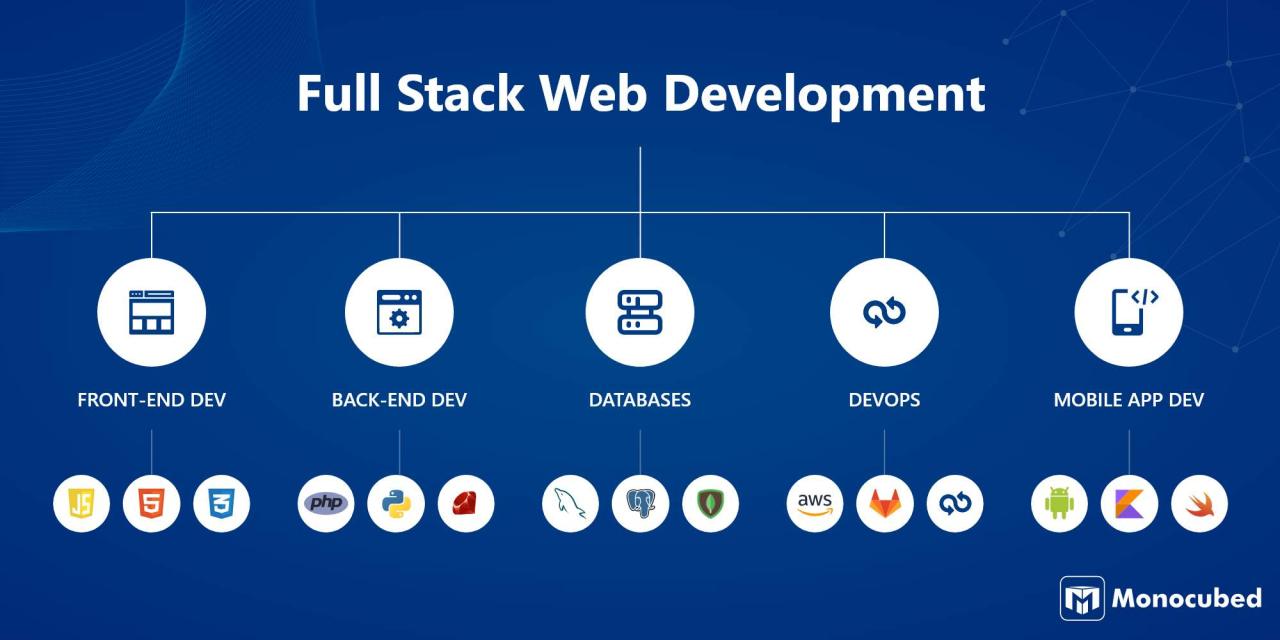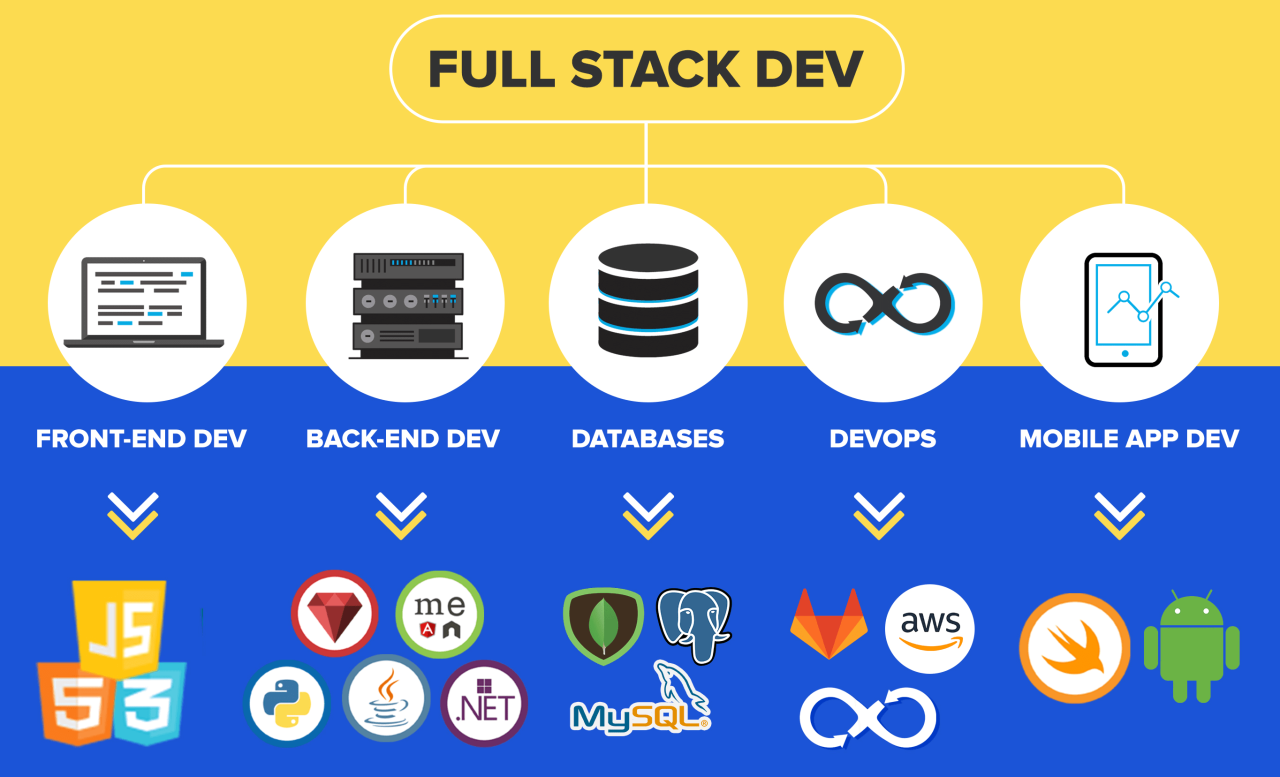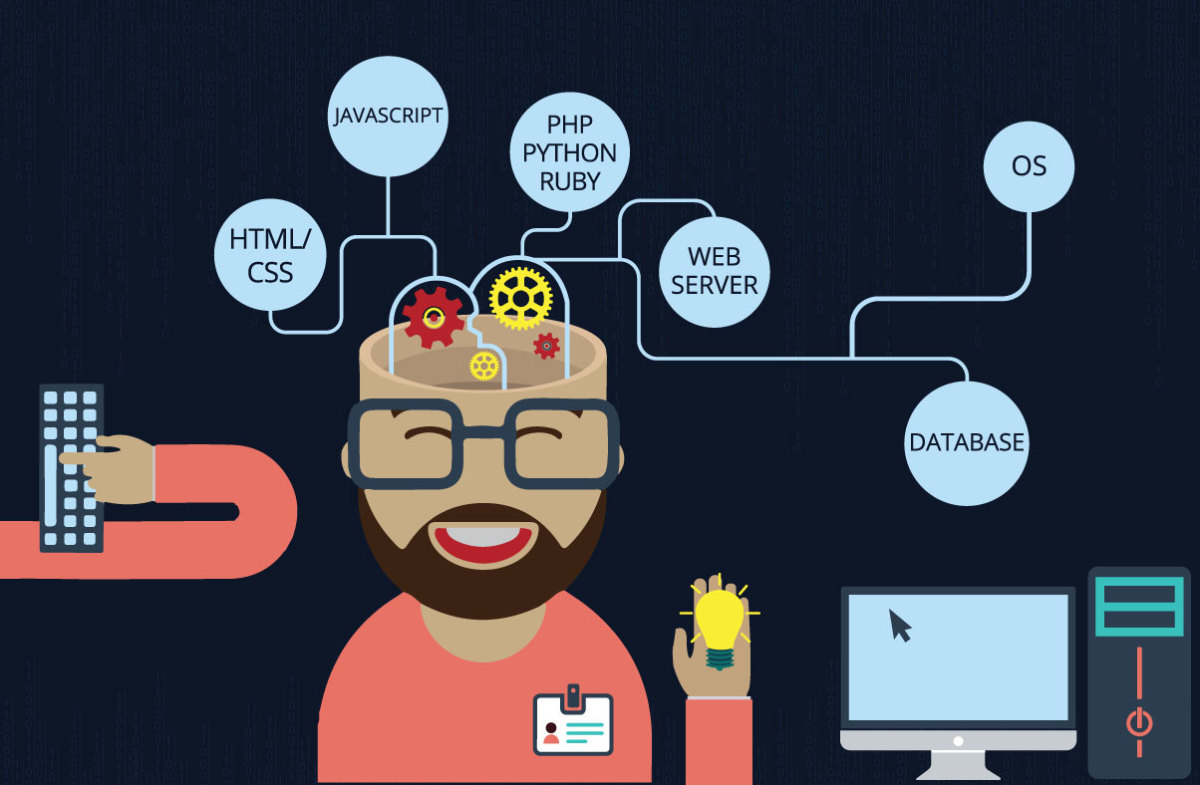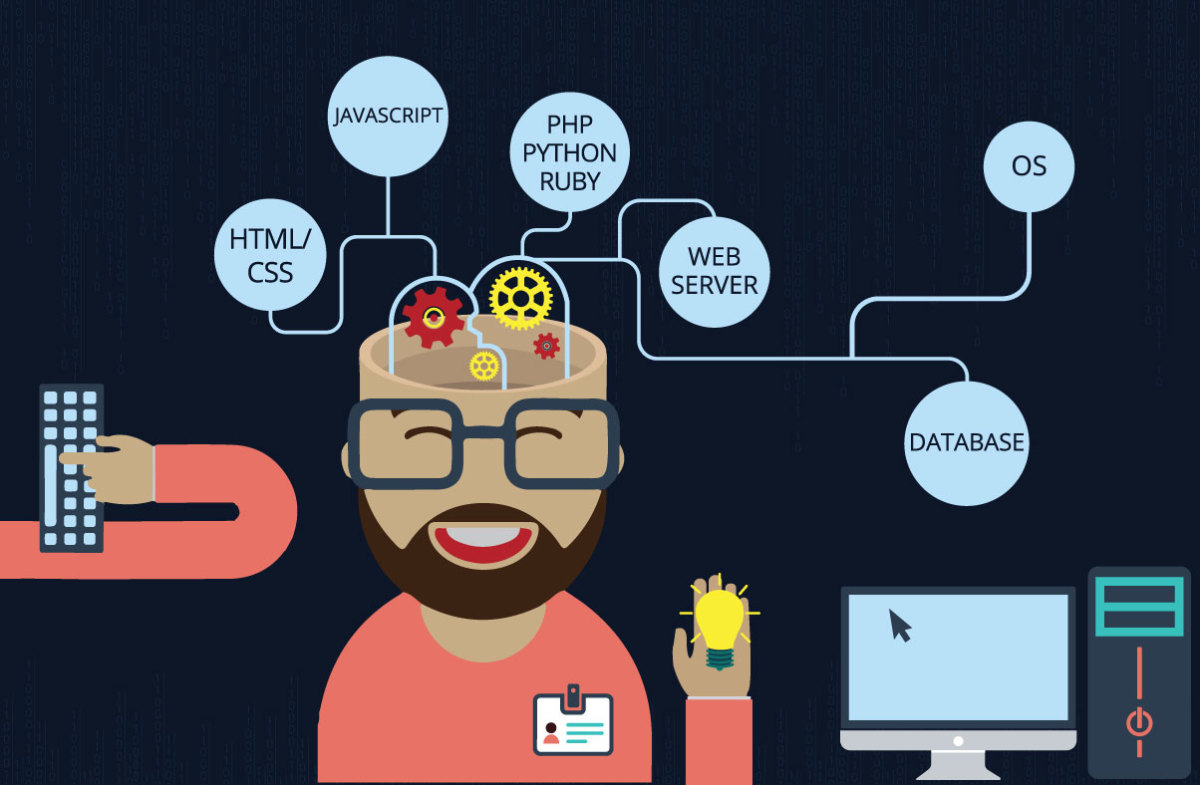Full stack developers are the modern-day digital Renaissance artists, fluent in both the front-end artistry of user interfaces and the back-end sorcery of databases and servers. They’re the masters of the entire web development ecosystem, bridging the gap between design and functionality. This guide provides a practical overview of this exciting and multifaceted career path, exploring the skills, methodologies, and challenges involved in becoming a successful full stack developer.
We’ll delve into the core competencies, essential technologies, and development workflows that define this role. We’ll examine the differences between front-end and back-end development, and discuss how a full stack developer seamlessly integrates these aspects to build complete, functional applications. We’ll also cover crucial topics like testing, deployment, and the ever-evolving landscape of emerging technologies impacting this field.
Defining Full Stack Development
Full-stack development encompasses the entire spectrum of software development, from the front-end (what users see and interact with) to the back-end (the server-side logic and databases). It’s about having a holistic understanding of how all the pieces fit together to create a functional and engaging application.
So you wanna be a full-stack developer? It’s a challenging but rewarding path, requiring mastery of both front-end and back-end technologies. Think of it like building a whole house, not just one room – and sometimes, even amidst all that coding, you need a break to check out celebrity gossip, like this story: Molly-Mae and Tommy Fury spark reunion rumours as they are.
Then, it’s back to the code! Becoming a full-stack developer takes dedication and continuous learning.
Core Competencies of a Full-Stack Developer
A full-stack developer possesses a broad skillset, bridging the gap between front-end and back-end development. They are proficient in both client-side and server-side technologies, understanding user experience (UX) and database management equally well. This allows them to build and maintain complete applications independently.
Front-End and Back-End Technologies
Front-end development focuses on the user interface (UI) and user experience (UX). Common technologies include HTML, CSS, JavaScript, and various JavaScript frameworks like React, Angular, and Vue.js. Back-end development handles server-side logic, databases, and APIs. Popular back-end technologies include Node.js, Python (with frameworks like Django and Flask), Java, PHP, Ruby on Rails, and databases such as MySQL, PostgreSQL, MongoDB, and others.
So you want to be a full stack developer? It’s a challenging but rewarding path! You’ll need to master both front-end and back-end technologies. Need a break from coding? Check out the game recap of the Lakers dominating the Hawks, Lakers 119-102 Hawks (Jan 3, 2025) Game Recap – ESPN , then get back to building those amazing web apps! Remember, persistence is key to becoming a successful full stack developer.
Comparison of Front-End and Back-End Developer Roles
While a full-stack developer handles both, front-end developers specialize in creating visually appealing and user-friendly interfaces, while back-end developers focus on the server-side logic, data management, and application security. In a full-stack context, these roles are integrated, with the developer understanding the interplay between the two.
Comparison of Popular Frameworks
| Framework Name | Primary Language | Key Features | Common Use Cases |
|---|---|---|---|
| React | JavaScript | Component-based architecture, virtual DOM, JSX | Single-page applications, user interfaces |
| Angular | TypeScript | TypeScript, MVC architecture, two-way data binding | Large-scale applications, enterprise solutions |
| Vue.js | JavaScript | Progressive framework, easy learning curve, reactivity | Single-page applications, interactive components |
| Node.js | JavaScript | Non-blocking, event-driven architecture, scalability | APIs, real-time applications, microservices |
| Django | Python | Object-relational mapper (ORM), security features, templating engine | Web applications, APIs, e-commerce platforms |
| Ruby on Rails | Ruby | Convention over configuration, MVC framework, rapid development | Web applications, APIs, startups |
The Skillset of a Full Stack Developer
Mastering full-stack development requires a diverse skillset encompassing programming languages, database management, version control, and various development tools. A strong foundation in these areas is crucial for building robust and maintainable applications.
Essential Programming Languages, Full stack developer
Full-stack developers typically need proficiency in at least one front-end language (like JavaScript) and one or more back-end languages (like Python, Java, or Node.js). Understanding multiple languages allows for flexibility and adaptability to different project requirements.
Importance of Database Management Skills

Database management is a cornerstone of back-end development. Full-stack developers need to understand database design, SQL queries, and data modeling to effectively manage and retrieve data within their applications. Proficiency in NoSQL databases is also becoming increasingly important.
Role of Version Control Systems
Version control systems, primarily Git, are essential for collaborative development. They track changes to code, enabling efficient teamwork, easy rollback to previous versions, and effective code management throughout the development lifecycle.
Common Development Tools and IDEs
- Integrated Development Environments (IDEs): VS Code, IntelliJ IDEA, Sublime Text
- Package Managers: npm, yarn, pip
- Debuggers: Browser developer tools, Node.js debugger
- Testing Frameworks: Jest, Mocha, Selenium
- Cloud Platforms: AWS, Google Cloud, Azure
Full Stack Development Methodologies: Full Stack Developer
Various methodologies guide the full-stack development process, each with its own approach to project management and workflow. Choosing the right methodology depends on project size, complexity, and team dynamics.
Different Approaches to Full-Stack Development Projects
Agile and Waterfall are two common methodologies. Agile emphasizes iterative development, flexibility, and collaboration, while Waterfall follows a linear, sequential approach. Other methodologies like Scrum and Kanban are also frequently used.
Hypothetical Project Workflow
A typical workflow might involve: requirements gathering, design, front-end development, back-end development, API integration, testing, deployment, and maintenance. Each stage requires careful planning and execution.
Testing Methodologies
Testing is crucial throughout the development lifecycle. Unit testing verifies individual components, integration testing checks interactions between components, and end-to-end testing ensures the entire application functions correctly. Automated testing is essential for efficiency and reliability.
Deploying a Full-Stack Application
- Prepare the application for deployment (e.g., build process, configuration).
- Choose a cloud platform (AWS, Google Cloud, Azure).
- Create a deployment environment (e.g., virtual machines, containers).
- Configure server settings (e.g., databases, web servers).
- Deploy the application code and dependencies.
- Test the deployed application.
- Monitor application performance and address any issues.
Challenges and Trends in Full Stack Development
The full-stack landscape is constantly evolving, presenting both challenges and exciting opportunities for developers. Staying current with new technologies and best practices is essential for success.
Challenges in Managing Multiple Technologies
The breadth of technologies involved can be overwhelming. Keeping up with updates, mastering different frameworks, and managing the complexity of diverse systems requires continuous learning and strong organizational skills.
Emerging Technologies and Trends
Artificial intelligence (AI), serverless computing, and blockchain technology are transforming the full-stack development landscape. Adopting these technologies can lead to innovative and efficient applications.
So you wanna be a full stack developer? It’s a challenging but rewarding path, requiring diverse skills. Think about the sheer scale of things – even the beauty of the night sky, like the amazing celestial show described in this article, Venus Moon duo and Quadrantids meteors stun stargazers , needs a whole system to be observed and documented.
That’s kind of like building a complex web application; you need to manage the front-end, back-end, and everything in between, just like the universe manages its own vast systems. Becoming a full stack developer is all about mastering those interconnected parts.
Architectural Patterns: Microservices vs. Monolithic
Microservices offer modularity and scalability, while monolithic architectures are simpler to develop and deploy initially. The choice depends on project requirements and long-term scalability goals.
Security Considerations
Security is paramount. Vulnerabilities can have severe consequences. Robust security practices are crucial throughout the development lifecycle.
Always validate user inputs, use secure authentication and authorization mechanisms, and regularly update dependencies to patch known vulnerabilities.
Implement appropriate security measures at every layer of the application, from the front-end to the database.
Regular security audits and penetration testing are essential to identify and address potential weaknesses.
Illustrative Examples of Full Stack Projects
Numerous applications showcase the power and versatility of full-stack development. Understanding the interplay between front-end and back-end components is key to building successful projects.
E-commerce Application
An e-commerce application would have a front-end with a product catalog, shopping cart, checkout process, and user accounts. The back-end would handle inventory management, order processing, payment gateway integration, and user authentication. Databases would store product information, user data, and order details. The user interface would use responsive design principles for optimal viewing across various devices.
Social Media Platform

A social media platform requires a user-friendly interface for creating posts, interacting with other users, and managing profiles. The back-end would manage user authentication, data storage (posts, comments, likes), notifications, and search functionality. The data flow would involve real-time updates and efficient data management to handle a potentially large user base. A newsfeed algorithm would be a key back-end component, personalizing the user experience.
Content Management System (CMS)

A CMS allows users to create and manage website content without needing extensive coding knowledge. The front-end provides an intuitive interface for content creation and editing. The back-end manages content storage in a database, user permissions, and potentially integrations with other services. The server-side logic handles content retrieval and display, ensuring secure access and efficient performance.
Final Review
Becoming a proficient full stack developer requires dedication, continuous learning, and a passion for crafting innovative solutions. While the challenges are real – mastering multiple technologies and staying current with rapid advancements – the rewards are immense. The ability to build entire applications from concept to deployment, wielding expertise across the entire stack, is incredibly empowering. This guide has equipped you with the foundational knowledge; now, it’s time to embark on your journey to mastering full stack development.
User Queries
What’s the average salary for a full stack developer?
Salaries vary greatly based on experience, location, and company size. Expect a wide range, but generally, experienced full stack developers command competitive salaries.
How long does it take to become a full stack developer?
There’s no single answer; it depends on your prior experience and learning pace. Dedicated individuals can achieve a basic level of competency in months, but mastering the field takes years of continuous learning and practice.
What are the best resources for learning full stack development?
Numerous online courses, bootcamps, and tutorials are available. Choose resources aligned with your learning style and experience level. Hands-on projects are key to solidifying your skills.
Is it better to specialize in front-end or back-end first?
Many developers specialize initially, gaining deep expertise before broadening their skills. However, starting with a balanced approach can provide a solid foundation.
